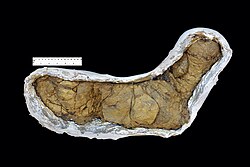

Coprolite Street is a street in Ipswich, Suffolk in the Waterfront area. It runs from Duke Street to Neptune Marina, the former Orwell Quay. [1] It was named after the factory which processed coprolite, or fossilised faeces, near Ipswich Docks. This factory was established by Edward Packard on the site of a former mill in 1849. [2] It is believed by local people to be the only Coprolite Street in the country [3] or even the world, and attracts geologists in particular who like to have their photograph taken by the street sign. [4]